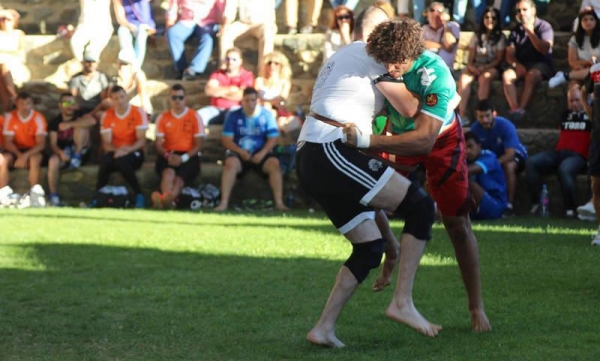Subscribe
Subscribe to our quarterly email newsletter 「ICM News」 to receive recent news about ICM, diverse writings by experts and youth, and relevant information.
Title [Martial Arts Globe] Opinon / Spain Traditional Martial Arts : Lucha Leonesa

-Carlos Lisart Avino
Lucha Leonesa is a fighting style strongly ingrained in the Spanish city of León and its folklore. It was declared intangible cultural heritage on 29th June 2017 by UNESCO. Also called Aluche, one of its main promoters, José Antonio Robles Tascon defines Lucha Leonesa as one of the most ancient fighting sports in Spain, with origins in the pre-romanian era and it still preserves its warrior and rural traces. It was traditionally practiced by men but has recently incorporated women to competition. The rules are simple: The opponents start the fight with an established grip on the belt and then they perform their techniques or “mañas”. If the opponent falls from his/her knees to his/her neck it is a complete fall, and it will be rewarded with a full point. The other way around, when the opponent falls to his/her sides or completely lessens the grip on the belt, the score would be medium point. The sum of these scores will constitute a victory. Regarding its relation with cultural heritage since we state that this term is not limited to monuments, galleries or even objects, it also includes traditions or living expressions inherited by our ancestors passed on through tales, entertainment, rituals, craftsmanship or festivities. Nowadays, in a world of constant change and globalization, intangible heritage is a fragile part of our society that are necessary to understand our history, and to establish dialogue and to respect others. As you can see, vast majority of traditional martial arts have a common and particular language associated with people´s life such as “mañas, tranque, garabito, cabrilada, tranca de la gocha...” which connects the sport with the culture of the village. Another point in common is the historical origins and artistic representations of these arts in other fields. A good example of this is his presence in craftsmanship, and scenes from temples like the “capitel de San Isidoro” or the “claustro de Santa Cathedral de León”. In literature, Lucha Leonesa appears quoted by the worldwide famous writer Miguelde Cervantes (born in Sanabria, León) in the acclaimed and recognized book “ElQuijote.” Antonio Barreñada, one of the main promoters, and representative of Leon University, claims that the reasoning behind the acknowledgement from UNESCO are based on historical and cultural considerations, looking at how this sport is still alive in the present of Leon´s life and its capability to influence through the years in the folklore of the territory. Despite these cultural expressions, it is not as spread in educational context such as Lucha Canaria or Pelota Vasca, a sports using a ball. This is precisely the next objective of its main defenders: Since we have already assumed Lucha Leonesa as a valuable good we want to keep, it should be recognized by the educational curriculum. For an intangible heritage to be preserved we need to first spread and second, to practice. On the contrary, tangible heritage just needs to be physically preserved, which may not be as difficult as preserving something intangible. When talking about preservation of the intangible, we must create a canon to unify the form of the determined practice, but this doesn´t exclude from upgrade and actualization. For example, rules of Lucha Canaria were diverse depending on the area of the Leonese territory where it was practiced. It wasn´t until 1917-1920 when the rules that define the competition of this sport were defined. Eleven years after that decision, the rules concerning the use of the belt or the way of the grip were unified. Maybe the limitation of creating a common background is tying down diversity, but in order to protect a practice we must first define exactly what it is. It is more practiced in the north of the territory, and has some resemblances with other spanish traditional martial arts such as Lucha Canaria but have also major differences: To begin with, Lucha Leonesa was first awarded as intangible cultural heritage (29th June as stated above), after that was “salto del pastor”, and lastly, lucha canaria in 2018. The field where it´s practiced is also different and observing the patterns and similitude, it has more resemblances with the “kabubu” fighting style from the Congo or the “koresh” from the Tartars. Lucha Canaria, on this way, shares more points in common with Korean “Ssireum” and with Senegalese fighting style. The fact of being intangible cultural heritage highlights its cultural values. This means we accept the citizenship responsibility as an educational tool for cultural transmission. As we can see, this acknowledgment means than these games or sports are more than that. They are also tools for building the next generation. In fact, that´s what the word “heritage” means: to share and pass on our knowledge from father to son, to one generation to the next.
※ This writing does not reflect the opinon of UNESCO ICM and UNESCO ICM is not directly linked to this writing. |
















